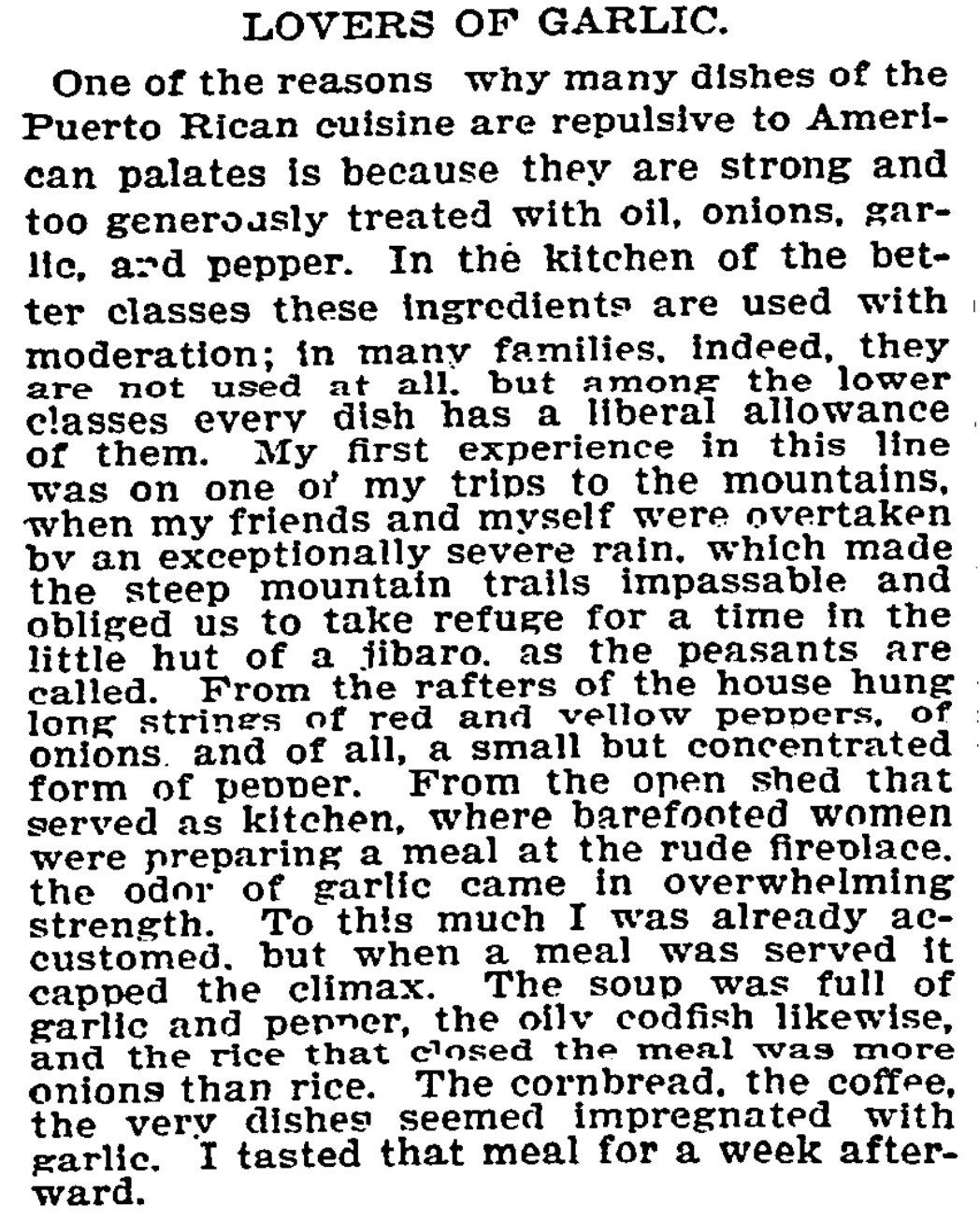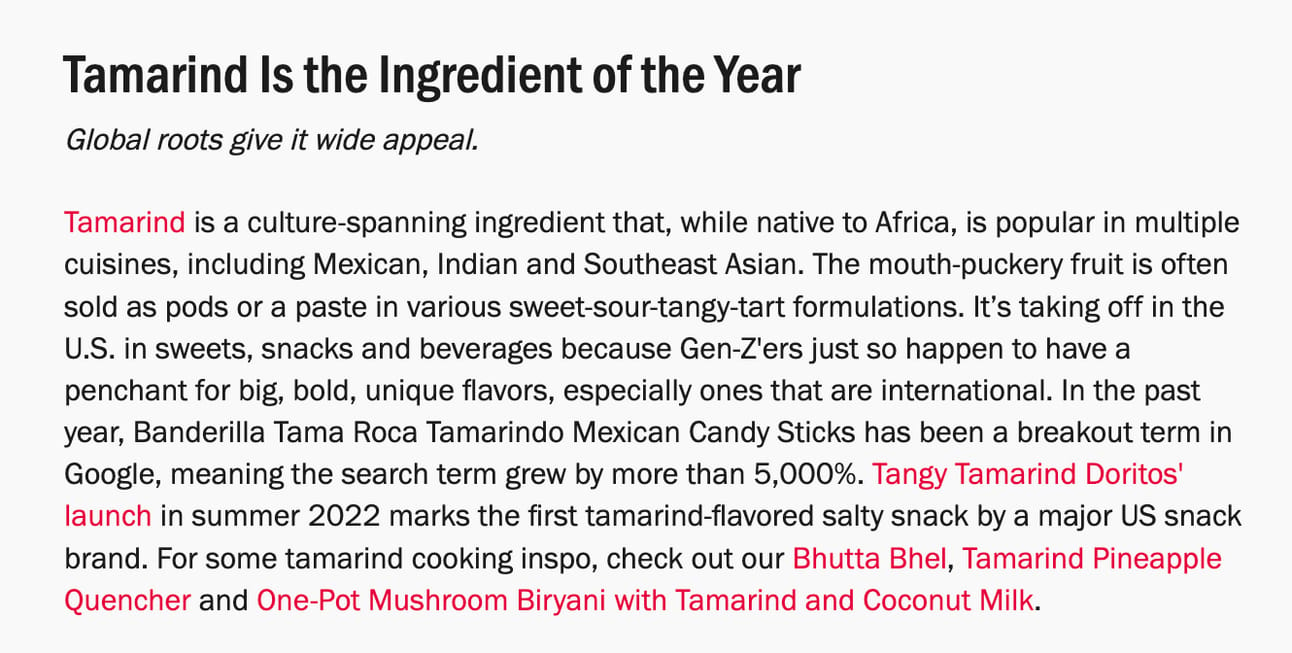
This is the third lecture in my Culinary Tourism class at Boston University’s masters of gastronomy program. I will be sharing these and reading suggestions throughout the semester, interspersed with my regular missives. Here are the first and second.
While I was working on this lecture, I was marinating tofu in shio koji for dinner and heating up penne in marinara for lunch. There was a time when this would have been an unthinkable and very odd event: All in one day, Italian and Japanese food? Made in a kitchen in Puerto Rico?
In re-reading the chapter titled “Okay, Let’s Stay Home” in Lisa Heldke’s significant 2003 work Exotic Appetites: Ruminations of a Food Adventurer, I asked myself, as she does, what would truly constitute my own “authentic” cuisine? My ethnic background draws evenly from Puerto Rico, Ireland, and Germany; my geographical home is a town called Patchogue, on Long Island, which was stolen from the Unkechaug tribe during colonial times. As a New Yorker and a millennial, I’ve long eaten food from various cultures, including Japanese, Italian, Mexican, Indian, Greek—the list goes on—many of which are built further upon the foods that moved around the world because of empire and colonialism. This is neither a utopian nor uncomplicated reality: It’s simply reality, for many of us, whose backgrounds and cultures have braided with others’ over time.
What Heldke proposes isn’t a denial of this, but an embrace; that in recognizing and opening up to difference, we are able to approach food and culinary tourism in a way that, to paraphrase Aimé Césaire in Discourse on Colonialism, places civilizations into contact rather than imposes one “correct,” hierarchical way through colonization.
“Influence is the rule, not the exception in cuisine—and influence runs in all directions, not only from the powerful to the powerless. All measures to prevent it—for reasons noble or nefarious—end up being partial at most,” Heldke writes. Indeed, she acknowledges that it would impoverish her own life to remain ignorant of other cultures. It is through restaurants, recipes, friendships, and indeed travel that one comes into contact with “other” cuisines. It is the nature of the contact that determines whether, as is Heldke’s pursuit, it is colonialist in nature.
Lisa M. Long in Culinary Tourism takes the notion that we can eat of “other” cuisines without leaving home farther, by suggesting we don’t even have to eat to be culinary tourists: “we can be culinary tourists without actually eating, or without leaving home. Perusing cookbooks and cooking magazines and watching cooking shows or films with food scenes off mental and emotional journeys to other food worlds.”
How have you learned about another cuisine that has been incorporated into your own eating and cooking?
Heldke’s perspective is a departure from the historical mode of colonization, in which empires replaced cultures entirely, and this impact has been deeply felt in cuisine: In Puerto Rico, it is said that the culture is a mix of Spanish, Indigenous, and African, and the cuisine follows that. But since 1898, the United States has also imposed its tastes and desires. The agriculture of the archipelago has long served the empire’s desires, whether for coffee or for sugar. The plantains and pork that are so deeply associated with the local cuisine are from Africa and Spain, respectively, and likely from Asia before that. The fast food that is easily accessible is generally from the States. A recent proliferation of Neapolitan pizza also comes from chefs being influenced and traveling, returning to add their spin on foods of the “other”; there is a simultaneous interest in using local root vegetables and seafood, which is likely more in line with how the archipelago’s original inhabitants ate. These are interesting turns that nonetheless don't make what is broadly understood as Puerto Rican food any less Puerto Rican. A cuisine is, as Heldke notes, the sum of ever-expanding influences from all directions.
Heldke and Long are both aware of the ways in which the U.S. adopts and adapts the foods of various cuisines—and in some cases, completely erases their origins to make them “American,” even if when they were introduced by immigrant groups, they were reviled. Garlic, for example, was disliked for its association with Italian immigrants—indeed, garlic was despised by white Americans traveling to Puerto Rico in 1898. This is excerpted from a Baltimore Sun travel missive reprinted in the Times. Now, garlic is a staple of home kitchens, whether in fresh, jarred, or powdered form (or all of the above). It’s a running joke on social media that there is no amount of garlic too small for any dish.

In her book Eight Flavors: The Untold Story of American Cuisine, food historian Sarah Lohman chronicles how garlic came to be utterly ubiquitous in the U.S. She writes, “Garlic maintained its anti-American connotations well into the twentieth century,” and notes that as late as 1939, a Life magazine profile of Italian-American baseball player Joe DiMaggio mentioned he “never reeks of garlic.” This is intended as a compliment.
The ways in which various ingredients and cuisines are subsumed into becoming “normal” in the U.S. is a fascinating aspect of “food adventuring,” as Heldke terms it. The Dean & DeLuca Cookbook, published in the 1990s by the famed New York City grocery store owners, notes that “once in America, ‘olives’ meant something positively awful” and not the selection we now have. Mushrooms, eggplant, and sun-dried tomatoes, as well as many grains, were commonplace ingredients in much of the world, but entered the U.S. through fancy grocers like Dean & DeLuca and chefs like Peter Hoffman of Savoy, who writes in his memoir What’s Good? A Memoir in Fourteen Ingredients that he switched from the French influence of butter to the Mediterranean olive oil in the 1980s. He writes, “As the foundational fat in cuisines of the Mediterranean...our interest in olive oil’s use marks the beginning of the decolonization of our collective culinary outlook… Olive oil opened the door for not only the Mediterranean cuisines to rise in popularity but by extension a vast range of non-Eurocentric cuisines…”
Nowadays, “international roots” are cited as a reason for an ingredient’s potential success in the U.S. market. Food Network’s predictions for 2023 food trends called tamarind the “ingredient of the year”:

Why do you think “global roots” are now a reason for an ingredient to be appealing, versus the past, when garlic was too “stinky” and things like sun-dried tomatoes and olive oil “trickled down,” so to speak, from grocers and chefs?
Navneet Alang's 2020 Eater piece on the question of "the global pantry" gets at the complications of such an idea. He writes, "the way we define what is contemporary and fashionable in food is tied to whiteness as a cultural norm."
To get back to Heldke's idea that "influence is the rule, not the exception in cuisine," Alang points out that while influence may be universal and move in all directions, it still relies on certain systemic power structures:
"You cannot have influence without authority. It’s why well-known (usually white) chefs and cookbook authors have historically been so effective in popularizing global ingredients among the North American mainstream."
He goes on to say, "In the circuits of culture, there are routes to legitimacy and fame, and the problem we have in the food world is that the most reliable path seems to center whiteness again and again."
To speak in culinary tourism terms, it's once again about how "cool" is defined and whether people are able to define their own cool. Do you believe whiteness is a major force in defining global standards of desirability in food?
But now that almost everything is available in the U.S., at least in major urban centers, the experience of travel and eating at the “source,” so to speak, becomes even more valuable. Or does it detract from a touristic experience to encounter the same things abroad as one sees at home? There is increasing homogenization of restaurants, especially: The phenomenon of a “Global Brooklyn” overtaking the cuisine and aesthetics of urban dining has been noted by Fabio Parasecoli and Mateusz Halawa. According to John Urry in The Tourist Gaze, the experience of everyday activities like eating and drinking take on novelty, are rendered “extraordinary” when undertaken in a different space.

The question becomes, how far in a globalized world must one go to find “a distinctive visual backcloth” now that so many foods are available in any Western grocer? It’s difficult not to imagine this “distinctive visual backcloth” is now literal, considering the role of social media in constructing desirable food destinations.
Does the ubiquity of other cuisines in one’s home city make culinary tourism more or less desirable?
Culinary tourism, as we discussed last week, becomes desirable only under certain conditions. Many places, including various Caribbean islands, play host to tourists but do not produce enough food to feed their own populations. (Garlic is so ubiquitous in Puerto Rican cuisine, yet none is grown locally at a commercial scale, forcing locals to make their sofrito with imported and often expensive garlic.) Kincaid notes this of Antigua in A Small Place; Angelique Nixon discusses it in her book Resisting Paradise: Tourism, Diaspora, and Sexuality in Caribbean Culture, with relation to the Bahamas. She writes that the focus on tourism and banking has left locals without support for agriculture, fishing, and other industries that would enable security and livelihoods that aren’t tourism-dependent.
Yet serving “local food” is a status marker in terms of culinary tourism. The statistic that 80 percent of food in Puerto Rico’s supermarkets is imported naturally leads the gastronomic experience of pricier “farm to table” restaurants to have more cachet—indeed, it was Cocina al Fondo and Vianda, which make a point of buying locally, that were recently named James Beard Award semifinalists.
Lois Stanford wrote the chapter “When the Marginal Becomes the Exotic: The Politics of Culinary Tourism in Indigenous Communities in Rural Mexico” in the book Reimagining Marginalized Foods: Global Processes, Local Places (which is available open access in full on Jstor). It looks at how Mexico’s government has sought international protection and recognition for various indigenous cuisines, owing to an increase in supermarkets and processed food availability. (A good book on this specifically is Alyshia Galvez’s Eating NAFTA.)

Stanford writes that in seeking international recognition for these indigenous cuisines—in attempting to make them of interest to the global culinary tourist—the Ministry of Tourism is reshaping them by removing context and enforcing the judgment of outsiders who don’t have knowledge of the cuisine, but do have what one might call a “global palate,” one defined by knowledge of Alang’s “global pantry.” It goes back to the discussion last week about whose palate defines a place or cuisine as “worthy” of being a destination. Once again we see how the in-members of these indigenous communities, mainly women, are not able to define and present their cuisine on their own terms, but must appeal generally to white men. “New Nordic” cuisine, as we discussed, was internally defined and argued by Danish chefs and accepted internationally on that basis.
How can culinary tourism be more aware of its effects on changing cuisines at their origin? Just as ingredients come into U.S. cuisine and markets when the “general” population is ready, do destinations become desirable when the global culinary tourist is “ready”? What defines that desire?
Week 4 class is on February 21st (I gave the students Valentine’s Day off). The class will be about glossy travel magazines and how they present culinary tourism, with students bringing in their own close reading. I’ll also be asking them to read Jonathan Nunn’s recent Vittles essay on traveling to Greece, “London Review of Souvlaki” as a point of comparison.

This Friday’s From the Kitchen dispatch for paid subscribers will include a recipe for a sweet-and-salty olive shortbread. It’ll be good preparation for next week’s essay, “On Martinis,” about what I’ve learned from ordering the same drink everywhere I go since 2017. See the recipe index for all recipes available to paid subscribers.

PublishedOh, nothing, but trust that your girl is working.ReadingA book to review for aforementioned work! I’m still in Kafka’s Diaries otherwise.
CookingI made the potato-leek momos from Hetty McKinnon’s fabulous To Asia, With Love for friends along with cabbage-mushroom dumplings. I will never again do a simultaneous steam and pan-fry situation, but everything went over well! I had to use shallot for the momos rather than leeks, which was funny considering I recently subbed scallions for leek and was like, “damn, leeks are so great” to the point that I wrote a whole paid subscriber post about it (it has great comments!). Above are pancakes that I made for Sunday breakfast.